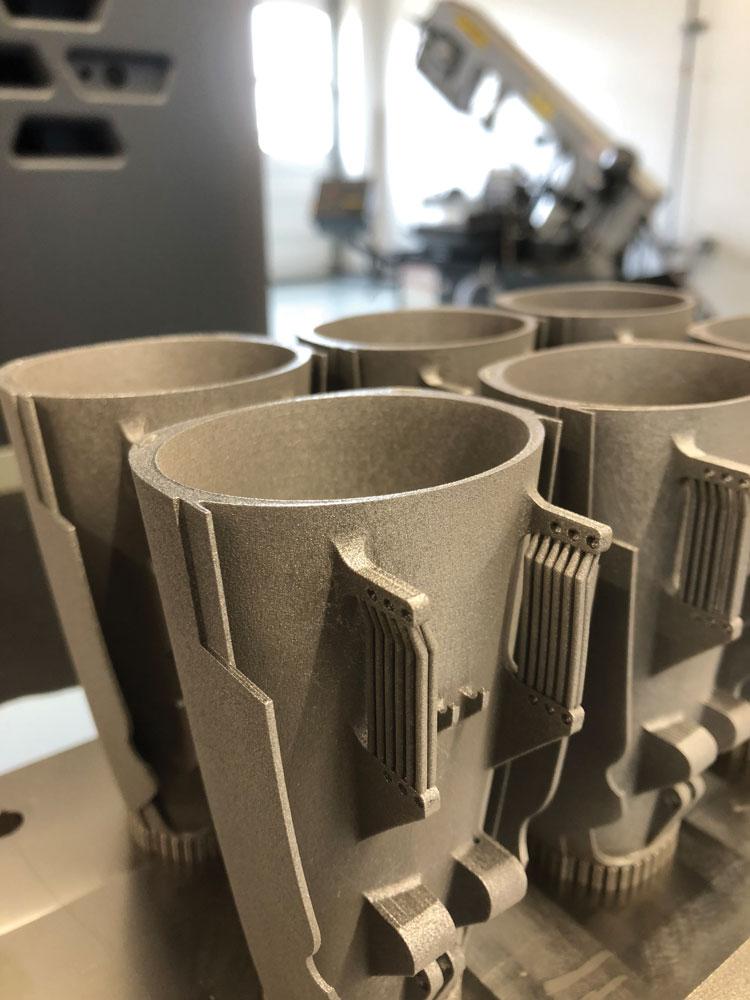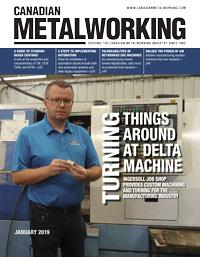Additive Manufacturing Business Manager
- FMA
- The Fabricator
- FABTECH
- Canadian Metalworking
Unlock the power of AM
Additive manufacturing enables entrance into new markets
- By Mark Kirby
- January 31, 2019
- Article
- Metalworking

The new printed stylus measures a part. In the background, an example of a selection of standard shafts and knuckle connections that it has replaced is shown. Photo courtesy of Renishaw.
Additive manufacturing (AM) has moved beyond its initial phase and into a production phase. The technology has advanced in terms of work envelope size, speed, and materials.
Metal AM technology has become more widespread, capable, and compelling.
The emergence of new machines and manufacturers offering directed energy (powder and wire) as well as binder jetting systems expands the addressable market for these machines.
This is alongside the dominant installed base of laser powder bed machines, which have become significantly faster, and multilaser platforms are now common. All of these technologies have different strengths, and this means careful consideration is required when you are looking to add this technology to your shop. However, for Canadian industry to watch and wait for something better is a dangerous strategy when the knowledge gap compared to Europe and the U.S. already is large.
Grow your base
Closing this gap is important. Adding AM to a shop’s core competencies is important because it can be used to grow a shop’s customer base, enabling new money to flow into the business.
However, this promise of new cash flow also is one of the most exciting and misunderstood promises of AM.
If we consider metal AM as just another manufacturing process, like, say, EDM, then the opportunity to grow the business simply by adding a new process capability is probably clear but limited. However, if the discussion to add AM also includes a new way to design parts, then AM opens up both new products and new markets for a business to grow.
AM often requires new design thinking to make a good business case. It is not typically a new manufacturing process that will more cost-effectively solve an existing production challenge. This is probably the source of most hype and disappointment, because AM blurs the traditional sequential line between design and manufacturing.
Most machine shops make parts to a customer’s drawing, and so opportunities for metal AM will be limited until those drawings are created with AM in mind. We would never try to produce a shaft on a milling machine, because it is obvious that a shaft is a turned part. However, because we can now print almost anything using one of the different AM technologies, confusion often creeps in.
If there is another, traditional way to produce a part, it usually is cheaper than metal printing.

Solid rocket fuel tanks for a high-speed drone have been created using additive manufacturing. Photo courtesy of Renishaw.
Cultural shift
As with most manufacturing processes, the devil is often in the details, and AM is no exception.
Knowledge needs to be acquired, and the talent pool for this equipment in Canada (and worldwide) is still small. Efficient training and support help companies move down the learning curve without having to experience all the pain of the early adopters.
We need to move toward scenario-based training (like pilots using flight simulators) to quickly develop more experts on, and off, the shop floor. Waiting to accumulate years of experience before becoming competent in metal AM is not a good option for Canadian industry.
So how will the next generation of designers use AM? Let’s examine how it is traditionally thought of.
The design challenges of traditional parts created using traditional methods probably have already been cost-effectively solved. AM cannot magically make an existing design cheaper. For large, multinational companies, there are nearly always three areas where AM can be deployed with good economics.
1. Prototyping. During prototyping new products can be tested rapidly and iterated upon without the need for any tooling. Tooling still will be needed for machining after printing, but plastic printing can be used very effectively for workholding when combined with advanced CNC probing.
2. Legacy parts. The second business case is for legacy parts that may now be out of production as a casting or a forging or simply required in very low numbers instead of a minimum economic batch quantity. These now can be printed. Carrying cost reductions can be dramatic, with millions of dollars of inventory removed.
3. New markets. New product/market scenarios now can be sought out, which is entirely new growth on the top line, as opposed to cost reduction lower down.
Because Canada has far fewer large companies than the U.S., the AM adoption rate by major OEMs will inevitably be slower, and the trickle down of AM designs into machine shops will be small unless shops can compete for export business.
A more optimistic scenario would see Canada’s more agile economy generating many new products for underserved market segments and exploiting AM as a disruptive technology.
Example 1: Part consolidation
One of AM’s benefits is that it can be used to create a single, complex part that replaces a multipart construct.
A recent project really showed how “we’ve always done it like this” can be improved upon, even when the current system has optimized, cost-effective individual parts.
When Renishaw’s customers need to create special access styli that are long and complex, a selection of standard shafts and knuckle connections are screwed together to give the required configuration. Unfortunately, every connection is a potential weak link, and in a fast-paced automotive production line, such a stylus, if accidentally knocked, can require time-consuming recalibration. Additive manufacturing allowed us to print a dedicated stylus as a single part.
We optimized the new stylus to resist the probe trigger forces with minimal mechanical deflection. This required numerous design iterations to simulate the deflection under load for different cross-section variations, cutouts, and stiffening elements.
Eventually we were able to design a stylus that had very low mass and, at the same time, high stiffness.
We printed a number of these styli in titanium at our Solutions Centre in Kitchener, Ont., and after stress relieving the workpiece, used NC Perfect Part software to align them for 5-axis finish machining. We tested the performance of the new printed stylus alongside the existing multipart, screwed stylus using our Equator shop floor gauge to run thousands of repeated inspections.
The printed stylus outperformed the old configuration with much better repeatability because of its single-piece construction.
This one simple project illustrates the AM design mantra of part consolidation, but in this situation, combining multiple pieces also provided an increase in system performance as well as a life cycle cost reduction with less downtime for recalibration.
Example 2: Prototyping
Entering new market segments is one of the leading reasons to get into AM. It can open a new revenue stream for any manufacturer. Aerospace is one of those sectors, but the lessons learned here can be applied to any industry.
In 2016 I was visiting my MIT thesis supervisor, Professor John Hansman, when he asked if we could look at metal printing as a possible means of producing a solid rocket fuel tank for a high-speed drone.
The drone, which weighed just a few kilograms, is designed to be launched from the wing of a jet and must maintain Mach 0.8 for several minutes.
This was the perfect example of exploring new product/market space with AM, because no other vehicle exists that combines near supersonic capability with very low weight. We offered to print development parts at the Solutions Centre to help solve some of the design challenges.
The drone body not only needed to be light and strong, it was to be split into two halves to enable the propellant charge to be loaded. It also would get very hot, so this made titanium an obvious material choice.
One of the first areas of uncertainty was the joint design for the two halves, so test sections were printed with different snap fit clearances for functional testing. Once this was proven, full-scale bodies were printed and a successful test firing was conducted in MIT’s rocket test cell.
The design has continuously evolved, and recently we printed a new tail section to enable servomotor testing of the aerodynamic control surfaces. We were able to integrate several parts into a single printed component, and the new design could be printed with no tooling cost burden, again illustrating the positive impact of choosing AM for prototyping.
This is a great example of the unique opportunity of metal AM, because it brings together so many unique capabilities, especially the new product/market opportunity for companies to grow their business.
Mark Kirby is additive manufacturing business manager for Renishaw, 905-828-0104, www.renishaw.com.
About the Author
Related Companies
subscribe now


Keep up to date with the latest news, events, and technology for all things metal from our pair of monthly magazines written specifically for Canadian manufacturers!
Start Your Free Subscription- Industry Events
MME Saskatoon
- May 28, 2024
- Saskatoon, SK Canada
CME's Health & Safety Symposium for Manufacturers
- May 29, 2024
- Mississauga, ON Canada
DiPaolo Machine Tools Open House 2024
- June 4 - 5, 2024
- Mississauga, ON Canada
FABTECH Canada
- June 11 - 13, 2024
- Toronto, ON Canada
Zoller Open House & Technology Days 2024
- June 12 - 13, 2024
- Ann Arbor, MI




















